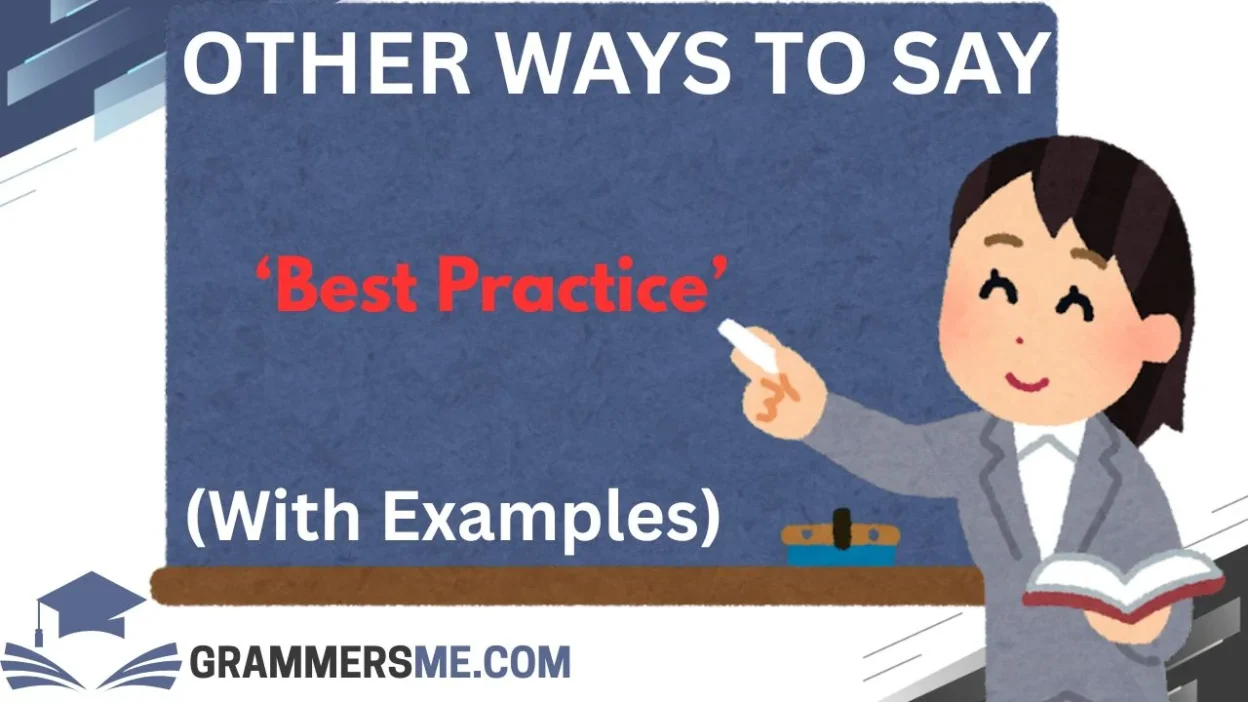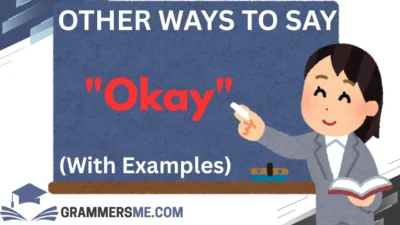When trying to communicate with warmth, care, and thoughtfulness, the right words can make all the difference. Whether you’re giving advice or sharing a strategy, the language you use shapes how your message is received. Sometimes, expressions like “best practice” can feel a bit formal or impersonal, especially when you want to create a more approachable tone.
That’s where alternatives come in. Here, we’ll explore 30 ways to express “best practice” with more warmth and empathy, making sure your messages are both clear and considerate.
What Does “Best Practice” Mean?
Before we dive into alternatives, it’s helpful to understand the meaning of “best practice”. In essence, a best practice refers to a method or technique that has been widely accepted as the most effective way of achieving a desired outcome. It’s the strategy that has been proven through experience or research to deliver the best results.
Is It Professional/Polite to Say “Best Practice”?
Yes, saying “best practice” is both professional and polite, especially in technical or business settings. However, it can come across as a bit impersonal.
If you want to foster a deeper connection with your audience while still offering valuable guidance, using one of the alternatives below can make your message feel more relatable and thoughtful.
1. Recommended Approach
Meaning: The suggested or favored method to accomplish a goal.
Detailed Explanation: This alternative softens the formality of “best practice” while maintaining professionalism. It implies that the approach has been carefully considered and is encouraged.
Scenario Example: “The recommended approach to addressing customer concerns involves listening carefully, offering solutions, and following up.”
Best Use: In any context where you want to offer a method that has been found to be effective, but without sounding too rigid.
Not Use: When you need to emphasize absolute authority or certainty in a method.
2. Ideal Method
Meaning: The most effective way to handle a situation, often regarded as the best choice.
Detailed Explanation: “Ideal method” carries a positive connotation, emphasizing that this way of doing things is not only effective but also desirable.
Scenario Example: “The ideal method for resolving this issue is to address the root cause, not just the symptoms.”
Best Use: When suggesting a preferred method that balances effectiveness with elegance.
Not Use: In situations where a flexible or adaptable approach is needed.
3. Effective Strategy
Meaning: A well thought-out plan or approach that achieves success.
Detailed Explanation: This phrase highlights both effectiveness and intentionality, suggesting that the method is thoughtfully designed.
Scenario Example: “An effective strategy for team collaboration involves clear communication and setting shared goals.”
Best Use: When describing a strategy that has proven to lead to successful outcomes.
Not Use: In casual, informal conversations where strategic thinking isn’t the focus.
4. Proven Approach
Meaning: A method that has been tested and shown to work.
Detailed Explanation: This alternative implies a track record of success, offering more reassurance that the approach will deliver results.
Scenario Example: “The proven approach to improving employee morale involves regular recognition and feedback.”
Best Use: When discussing methods that have been shown to work over time.
Not Use: When you’re in the early stages of testing a method.
5. Tried-and-True Method
Meaning: An approach that has been used for a long time and is well-established.
Detailed Explanation: This phrase carries a sense of reliability and tradition, making it perfect for situations where the approach is dependable.
Scenario Example: “The tried-and-true method for successful sales is building genuine relationships with clients.”
Best Use: When referring to methods that have stood the test of time.
Not Use: When you’re presenting new or innovative approaches.
6. Optimal Approach
Meaning: The best possible method in a given situation.
Detailed Explanation: “Optimal” implies that the method is the most effective solution available. It’s commonly used in analytical or technical contexts.
Scenario Example: “The optimal approach to cutting costs is to streamline operations without sacrificing quality.”
Best Use: When you want to emphasize that a method provides the greatest benefit.
Not Use: When flexibility or creativity is needed over strict efficiency.
7. Recommended Method
Meaning: The method suggested as being most beneficial.
Detailed Explanation: This one is similar to “recommended approach,” but it may feel a little less formal. It’s a gentle nudge toward the best course of action.
Scenario Example: “The recommended method for managing deadlines is breaking projects down into smaller tasks.”
Best Use: When offering advice or suggestions to a group.
Not Use: When you need to assert that one method is unquestionably the best.
8. Standard Procedure
Meaning: The accepted or established process for carrying out a task.
Detailed Explanation: This phrase often refers to routine processes that are followed in an organization or field. It emphasizes consistency and reliability.
Scenario Example: “Following the standard procedure ensures the quality and safety of our products.”
Best Use: In professional or technical contexts where consistency is key.
Not Use: In more creative, dynamic environments where flexibility is more important.
9. Best Solution
Meaning: The most effective and appropriate answer to a problem.
Detailed Explanation: This phrase can be used in situations where you’re addressing a problem and proposing a method that will solve it in the best way possible.
Scenario Example: “The best solution to improving customer service is better training for our staff.”
Best Use: When identifying the most effective way to solve a problem.
Not Use: When there are multiple potential solutions or when flexibility is needed.
10. Preferred Method
Meaning: The method that is most commonly chosen or thought of as the best.
Detailed Explanation: “Preferred method” suggests that this is the method most often recommended or used, though not necessarily the only option.
Scenario Example: “The preferred method for data analysis is using a combination of qualitative and quantitative approaches.”
Best Use: When offering a common or popular approach that works well in many situations.
Not Use: When discussing cutting-edge or experimental techniques.
11. Tried-and-Tested Approach
Meaning: A method or strategy that has been used repeatedly and shown to be successful.
Detailed Explanation: This phrase highlights that the method has undergone thorough application and has consistently proven to be reliable.
Scenario Example: “The tried-and-tested approach to improving customer satisfaction is always to ask for feedback and make timely improvements.”
Best Use: When referring to strategies or methods that have been used extensively and have yielded positive results over time.
Not Use: When a method is new or hasn’t been fully proven yet.
12. Most Efficient Method
Meaning: The method that uses the least amount of resources (time, money, effort) to achieve the best results.
Detailed Explanation: Efficiency is at the core of this phrase, focusing on methods that maximize productivity while minimizing waste.
Scenario Example: “The most efficient method for managing emails is to categorize them into folders and respond in batches.”
Best Use: In situations where efficiency and productivity are key, such as time management or workflow optimization.
Not Use: When the focus is more on creativity or flexibility rather than efficiency.
13. Cutting-Edge Technique
Meaning: A modern and innovative method or process that incorporates the latest advancements.
Detailed Explanation: “Cutting-edge” conveys that the method is not only effective but also ahead of the curve, often incorporating new technology or innovative thinking.
Scenario Example: “The cutting-edge technique for marketing involves using AI tools to personalize ads for customers.”
Best Use: When talking about the latest, most innovative methods in fields like technology, marketing, or design.
Not Use: When referring to established, traditional methods that are not innovative.
14. Time-Honored Practice
Meaning: A method or practice that has been used successfully for many years, often passed down through generations.
Detailed Explanation: This phrase evokes a sense of tradition and wisdom, implying that the method has stood the test of time.
Scenario Example: “A time-honored practice in leadership is leading by example and building trust with your team.”
Best Use: When referring to long-standing practices or values that are still relevant and respected.
Not Use: When discussing newer or evolving methods that are yet to be proven.
15. Dependable Approach
Meaning: A method or process that consistently produces reliable results.
Detailed Explanation: This emphasizes reliability and trustworthiness, making it ideal when describing methods that can always be counted on to work.
Scenario Example: “The dependable approach for handling difficult customer inquiries is to stay calm and listen attentively.”
Best Use: When you want to emphasize consistency and reliability.
Not Use: When highlighting methods that require more flexibility or adaptation.
16. Reliable Method
Meaning: A proven way of doing something that can be counted on to deliver good results.
Detailed Explanation: Similar to “dependable approach,” this suggests that the method works well under most circumstances and is trusted by many.
Scenario Example: “The reliable method for reducing waste in manufacturing is to track inventory closely and optimize the production process.”
Best Use: In situations where the focus is on trustworthiness and consistency.
Not Use: When discussing methods that may not always deliver predictable results.
17. Success-Oriented Strategy
Meaning: A plan of action designed with the ultimate goal of achieving success in mind.
Detailed Explanation: This alternative focuses on achieving desired outcomes and highlights the strategic thought behind the method.
Scenario Example: “The success-oriented strategy for growth is to continuously innovate and adapt to market changes.”
Best Use: When emphasizing that the strategy is built with a clear goal of success in mind.
Not Use: When you’re discussing methods that are more exploratory or uncertain.
18. High-Performance Strategy
Meaning: A plan that is designed to produce excellent, optimal results, often under high demands.
Detailed Explanation: This focuses on efficiency and effectiveness at a high level, typically used in contexts that demand top results, such as in business or sports.
Scenario Example: “A high-performance strategy for project management is setting clear milestones and regularly reviewing progress.”
Best Use: When discussing approaches that require exceptional performance and outcomes.
Not Use: In low-pressure situations or when the focus is on learning and experimentation.
19. Clear-Cut Method
Meaning: A straightforward, simple, and unambiguous method.
Detailed Explanation: This method is easy to follow and clearly outlined, often favored in situations that require a no-nonsense approach.
Scenario Example: “The clear-cut method for dealing with complaints is to acknowledge the issue, offer a solution, and follow up.”
Best Use: When the process needs to be simple and free from ambiguity.
Not Use: When the situation is complex and requires nuanced thinking.
20. Industry Standard
Meaning: The method or practice that is widely accepted and used within a particular industry.
Detailed Explanation: This phrase implies that the method is so common and effective that it has become the norm within the field.
Scenario Example: “Using email marketing automation is the industry standard for businesses looking to scale their marketing efforts.”
Best Use: When referring to widely adopted practices or methods that have become commonplace in an industry.
Not Use: When you’re discussing innovative or niche methods that are not widely accepted yet.
21. Foolproof Method
Meaning: A method so simple and effective that it cannot fail.
Detailed Explanation: “Foolproof” suggests that the method is easy to implement and guarantees results, even for those who might not be experts.
Scenario Example: “A foolproof method for staying organized is to use a calendar to track both personal and professional tasks.”
Best Use: When recommending something that’s easy and reliable for most people to follow.
Not Use: When dealing with complex, multi-step processes that require expertise.
22. Consistent Practice
Meaning: A method that produces reliable results each time it is applied.
Detailed Explanation: This emphasizes the importance of repetition and regularity, ensuring that results will be stable and dependable over time.
Scenario Example: “Maintaining a consistent practice of clear communication can significantly improve team dynamics.”
Best Use: When discussing practices that need to be performed regularly to achieve the best results.
Not Use: When you’re talking about spontaneous or situational approaches.
23. Refined Process
Meaning: A method that has been improved and perfected over time.
Detailed Explanation: This phrase suggests that the method has undergone adjustments and fine-tuning to make it more effective and efficient.
Scenario Example: “A refined process for onboarding new employees ensures they feel welcome and well-prepared for their role.”
Best Use: When discussing methods that have been enhanced through feedback and iteration.
Not Use: When the method is still in development or is untested.
24. Smart Approach
Meaning: A method that is clever, well thought out, and likely to produce positive results.
Detailed Explanation: “Smart approach” highlights intelligence and strategy behind the method, implying that it is a well-informed choice based on knowledge and insight.
Scenario Example: “Taking a smart approach to networking involves building authentic relationships over time rather than aiming for quick wins.”
Best Use: When recommending a method that combines foresight, resourcefulness, and careful planning.
Not Use: When recommending something that may be seen as too complex or out of reach for the audience.
25. Thoughtful Strategy
Meaning: A carefully considered and intentional plan designed to achieve a desired outcome.
Detailed Explanation: This term suggests that the strategy has been crafted with attention to detail and with the welfare of all parties in mind, making it both considerate and effective.
Scenario Example: “A thoughtful strategy for employee engagement ensures that the needs of both the organization and the staff are met.”
Best Use: When you want to convey that a strategy is not just effective, but also considerate and well-planned.
Not Use: When you need to convey something that is more immediate or requires less consideration.
26. Effective Technique
Meaning: A method that is capable of producing the desired result in a reliable way.
Detailed Explanation: This phrase highlights the effectiveness of a method, ensuring that it is successful in achieving the intended outcome.
Scenario Example: “An effective technique for boosting productivity is setting specific, measurable, and achievable goals.”
Best Use: When you’re discussing methods that have been proven to achieve the desired results.
Not Use: When you’re referring to techniques that may still be experimental or untested.
27. Impactful Practice
Meaning: A method that makes a significant difference or produces meaningful change.
Detailed Explanation: This phrase emphasizes that the practice doesn’t just work, but it makes a lasting, positive impact.
Scenario Example: “Implementing an impactful practice of active listening in team meetings can create a more collaborative environment.”
Best Use: When you want to highlight methods that lead to meaningful, lasting results.
Not Use: In casual situations where the focus is on day-to-day actions rather than significant impact.
28. Proactive Solution
Meaning: A solution that anticipates problems and addresses them before they arise.
Detailed Explanation: “Proactive solution” conveys the idea of being ahead of the curve, preventing issues before they happen rather than reacting to them later.
Scenario Example: “A proactive solution to customer complaints is setting up a feedback system to address concerns early.”
Best Use: When discussing methods that focus on prevention and foresight.
Not Use: When you are dealing with problems that need immediate reactive solutions.
29. Carefully Crafted Method
Meaning: A method that has been thoughtfully designed with attention to detail and purpose.
Detailed Explanation: This phrase suggests that the method has been intentionally and precisely designed, often with specific outcomes in mind.
Scenario Example: “The carefully crafted method for introducing new products involves market research, focus groups, and careful timing.”
Best Use: When describing a method that has been deliberately and intentionally developed to achieve success.
Not Use: When talking about something that is still in the planning or experimental stages.
30. Balanced Approach
Meaning: A method that takes multiple factors into account and ensures no single aspect is overemphasized.
Detailed Explanation: A balanced approach involves weighing different perspectives or goals, ensuring that the final method is well-rounded and comprehensive.
Scenario Example: “The balanced approach to conflict resolution involves listening to all parties, understanding their concerns, and finding common ground.”
Best Use: When discussing methods that integrate various viewpoints or solutions to achieve harmony or equilibrium.
Not Use: When the situation requires a more focused or singular approach.
Conclusion
By using these 30 alternatives to the term “best practice”, you’re able to communicate with more warmth, empathy, and thoughtfulness. Language has the power to shape how your message is received, and these alternatives allow you to offer advice, share strategies, and give guidance in a way that feels more personal and connected.
Experiment with these phrases to make your communication more compassionate, whether you’re in a meeting, sending an email, or having a casual conversation. Remember, the way you say something often matters just as much as what you say!
FAQs
1. How do I decide which alternative to use in a conversation?
It depends on the tone and context. For more formal settings, phrases like “industry standard” or “standard procedure” work well. In more casual or personal contexts, alternatives like “smart approach” or “thoughtful strategy” might feel more appropriate.
2. Should I avoid using “best practice” altogether?
Not at all! “Best practice” is still appropriate in certain situations, particularly when you need to present something as a well-established and proven method. However, mixing in these alternatives can help make your communication more flexible and approachable.
3. Are these alternatives suitable for giving feedback?
Yes, absolutely! Phrases like “recommended approach” or “carefully crafted method” can help soften feedback while still conveying that the advice is valuable and well thought-out.
4. Can these alternatives be used in marketing or advertising?
Definitely! In marketing, using terms like “cutting-edge technique” or “impactful practice” can highlight the effectiveness and innovation of your offerings in a more engaging way.
5. How can I ensure that these alternatives sound authentic in my writing?
To make these alternatives feel authentic, try to integrate them into the flow of your natural voice. You can mix them in thoughtfully depending on the audience and situation. Practice using them in different contexts to make sure they fit seamlessly into your style.




